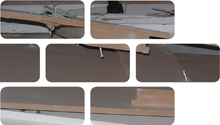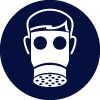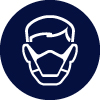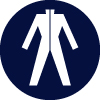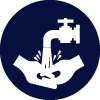
MDF 17 02 01
MDF (medium-density fibreboard) is an engineered sheet material manufactured from wood fibres, wax and a resin binder. It is denser than chipboard or plywood and may contain fire retardant and/or water resistant additives. The wood fibres are mostly from chipped and ground hardwood or softwood, but may also be from recycled timber, recycled paper, bamboo and forest thinnings. MDF is produced in a range of standard sheet sizes of various thicknesses and finishes, depending on the specification required. MDF is also manufactured in dimensional lengths with moulded edges or profile surfaces to suit architectural requirements. Some will have a finished veneer or coating for use in furniture, kitchen units and building products. Beware of water damaged sheets that have expanded and are weakened. Beware of dust and fibres when cutting MDF which may contain formaldehyde which is a 'known human carcinogen'.
Usage & Probable Locations
Personal Protective Equipment
PPE requirements indicated are for guidance purposes only. DRIDS has identified the PPE that is mandatory on all demolition projects and ones that may be required subject to site specific Risk Assessment & Method Statement (RAMS). Hover over the icon to determine the types of PPE required for the removal of this material.
Removal, Segregation & Storage
Depending on how MDF sheets or mouldings have been fitted, will determine how they are removed, segregated and stored. MDF sheets or products that are in good condition and not water damaged may have some reuse value. They should be segregated and stored flat on a suitably sized pallet, preferably inside and covered with plastic or tarpaulin sheets to keep them dry and prevent splash damage. MDF destined for recycling or recovery can be stored in a similar fashion, but is often added to a timber only skip along with other wood waste.
Tools
Fixtures, Fittings & Connections
MDF sheets, mouldings, panels, units and worktops are generally fixed in place with nails, screws, T-nuts and bolts, glues or adhesive. For some wall panel systems, the MDF sheets will tightly run inside metal, timber or plastic channels without the need for fixings. Flat worktops that usually include a veneer will be fixed underneath. Kitchen units will include various types of fixing screws, nails, gromets and dowels. MDF panels and doors will incorporate a layer of foam insulation or corrugated cardboard glued to the sheets. Skirting boards, architrave, picture rails and covings will be fixed with screws, nails or adhesive.
Health & Safety
Subject to task-specific Risk Assessment & Method Statement (RAMS). Use correct protective equipment for removing fixings, especially nails and screws. Wear gloves and long sleeve overalls when handling sheets with damaged edges, coated in paints or veneer to prevent irritation and cuts. Wear eye protection when removing nails, screws or other fixings with a crowbar, hammer or nailbar. Do not walk on wet and slippery sheets that are painted or coated in veneer. A respirator and goggles should be worn when cutting the materials and always in a controlled and ventilated environment.

